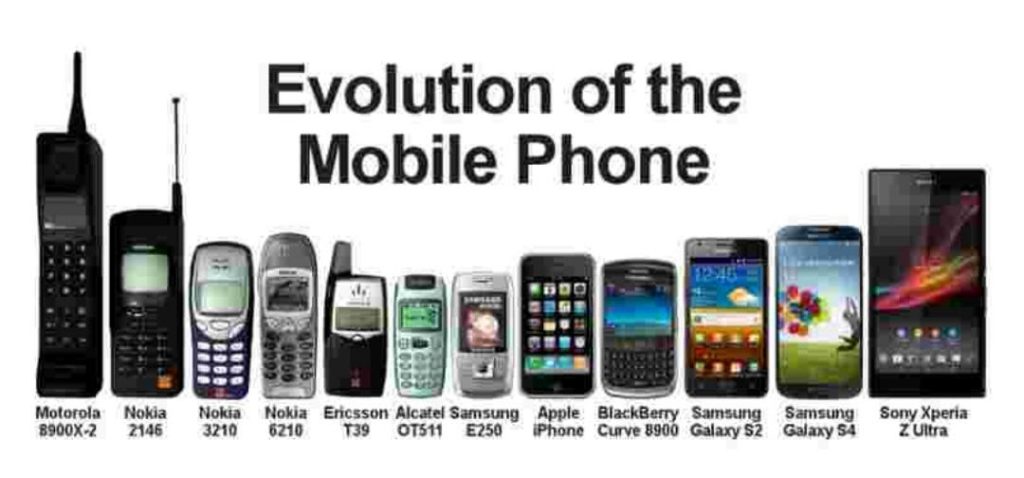Mobile phones evolution – Updates on AI & Technology by Outreinfo
Highlights:
- Motorola DynaTAC, the world’s first mobile phone.
- The world’s pioneering smartphone, The IBM Simon.
- Modern mobiles evolve into multi.
The birth of the mobile phone and the early years were an important contribution of Motorola. In 1983, Motorola introduced the first mobile phone, DynaTAC. It is remembered for its evaluation style and convenience, which ushered in the era of mobile communication.

Martin Cooper. Dr. Cooper was a senior engineer at Motorola. designed and invented Motorola DynaTAC mobile phone He tested Motorola DynaTAC for several years before its launch in the market. As a matter of trivia, DynaTAC’s full name was “Dynamic Adaptive Total Area Coverage”. The battery of this mobile was approximately 2.2 pounds and its battery time was only 30 minutes, whereas a full charge took 10 hours.
DynaTAC mobile was also called the ‘brick phone’ because its size and weight were like a brick. It was the first commercially available mobile phone, priced at approximately $3,995 phone, considered a very expensive mobile phone in its time.
Its introduction ushered in a new revolution in mobile communications. The number of limitations that the first phone had was much higher than today’s smartphones, but for that time it was an excellent technology.
Motorola’s opened a new chapter in the scientific community and was followed by many innovations in the technology of mobile phones. The way we use mobile phones today results from Motorola DynaTAC’s thoughtfulness and innovative approach. This phone was not only a technological achievement, but it also revealed future possibilities in mobile/telephonic communications.
In the early years of mobile phones, their size and design were very high. Those phones were also very heavy, and it was a little difficult to carry them together. When mobile phones were introduced, according to the standards of technology of that time. Despite this, for that time this phone was a symbol of amazing technology and made people appear to be connected. As technology evolved, mobile phones became smaller and designed to make them even lighter.
After the launch of Motorola DynaTAC, many innovations took place in the mobile phone world in the 1980s and 1990s. Motorola launched MicroTAC in the market in 1989, which was considered the smallest and lightest mobile phone of that time. Two years earlier, in 1987, Nokia had launched its Cityman 900, which later became popular.
And then In the birth and early years of mobile phones, the main function of these devices was only for voice communication. When there was not so much progress in the convenience of smartphones and the internet, people used mobile phones only for conversation.
Mobile phones mainly aim to communicate through voice. During that time, it was called the “cellular telephone” because it functioned using cells (a type of radio communication network). Phones cannot connect with the internet, gaming apps, or click photos, which are among the main features of today’s smartphones.
Earlier, the design and size of mobile phones kept changing, but their main function remained – voice communication. Motorola, Nokia, and other major manufacturers made it simple and improved it even more.
The beginning of mobile phones resulted from new technology, and its manufacture required proper technology and resources. Therefore, the price of these phones was very high, making it out of reach of the normal human.
Gradually, as technology evolved, new features were added to phones. But until the invention of the smartphone, the main function of mobile phones was only for voice communication. The mobile phone industry witnessed unprecedented changes following the launch of the IBM Simon mobile phone.
It was the first mobile phone with an Internet connection and a touch screen launched by IBM Simon. It was created by Frank J. Canova Jr and was introduced in 1992. The IBM Simon is also considered the world’s first smartphone as it included features such as a calendar, phonebook, clock, and notepad and was based on a touch screen. A company called IBM launched it and its price structure was $899.
At that time, using a mobile phone was considered a symbol of prestige. These were people who were in big positions in business or personal terms who needed mobile phones. Most people considered it to be an opulence garment that was out of their reach.
The Simon was the first device to feature a touch screen and digital assistant. The freshness of technology and the process of standardization made the phone more useful and helpful. Companies such as Nokia, BlackBerry, and Palm began developing phones with email, Web browsing, and other Internet services.
In 2007, Apple launched its first smartphone, the iPhone. Its arrival brought a new boom to the mobile phone market, and it helped set a new direction in user interface and application development.
Nokia, a company from Finland, started in 1865. Initially, it was established as a paper mill. In the late 20th and early 21st centuries, Nokia Jumped into the mobile manufacturing business and revolutionized the telecommunications industry worldwide. Thus, the rapidly growing mobile phone industry completely changed the way people communicate.
Motorola, the company that launched DynaTAC, is still present in the mobile phone market. It has mostly released midrange and premium range smartphones. However, Motorola’s identity is not as prominent as before, as other excellent brands in the market such as Samsung, Apple, Xiaomi, Oppo, Vivo, etc. have gained more market share.
After the success of DynaTAC, demand for mobile phones increased, and it became clear that it was a modern and extremely useful technology. As a result, various companies began to enter mobile production. With time, mobile phones became important not only for communication but also for various other functions, such as gaming, web browsing, video streaming, etc.
Today, mobile phones have become a necessity for everyone because it’s a necessity and cheaper as well. It engages us for communication, information, entertainment, and many other uses. Along with this, it also provides us with security and help, such as getting emergency services or using maps.
Today the annual revenue of the mobile phone market is in the billions of dollars. Updates on AI & Technology by Outreinfo continues to track these advancements, providing insights into how technology is shaping the future of mobile communications.

